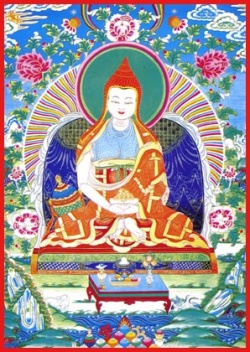Vimalamitra
Vimalamitra (in Sanskrit) (Chinese: 無垢友 (pinyin: Wúgòuyǒu); Tibetan: དྲི་མེད་བཤེས་གཉེན་ (Drime Shenyen, Wylie: Dri-med Bshes-gnyen)), an 8th century Indian Dzogchen adept. According to tradition, he was born in Western India. Vimalamitra received the transmission of Dzogchen from Shri Singha and Jnanasutra. He was also a student of Buddhaguhya. He was invited to Tibet by emissaries of King Trisong Detsen where he established himself as a teacher and translator of Dzogchen texts. Vimalamitra eliminated all delusion, thereby gaining complete realization (rainbow body)
Nomenclature, orthography and etymology
"Drime Shenyen" (Tibetan: དྲི་མེད་བཤེས་གཉེན་, Wylie: dri med bshes gnyen) and in devotion by the contracted "Vima" (Tibetan: བི་མ, Wylie: bi ma). Orthographic renderings of the Sanskrit differ e.g. Vimilamitra and Vimalamitra.
Detail
Seventeen Tantras and assorted Nyingtig
Gyatso (1998: pp. 153–154) relates how the Seventeen Tantras, though not considered terma, were revealed in a terma-like manner:
- By the eleventh century, both Bonpos and Buddhists were presenting texts they claimed to have unearthed from the place where those texts had been hidden in the past. Among the earliest Buddhist materials so characterized were the esoteric Nyingtig, or "Heart Sphere", teachings, including the seventeen Atiyoga tantras, which were associated with Vimalamitra, an Indian Great Perfection master invited to Tibet, according to some accounts, by Trisong Detsen in the eighth century. Vimalamitra's Tibetan student, Nyangban Tingzin Zangpo, was said to have concealed these teachings after the master went to China. The discoverer was Neten Dangma Lhungyal (eleventh century), who proceeded to transmit these teachings to Chetsun Senge Wangchuk, one of the first accomplished Tibetan Buddhist yogins, and to others. The Nyingtig materials were at the heart of the Great Perfection Buddhism and had considerable influence upon Jigme Lingpa, who labelled his own Treasure with the same term.
Translations
Vimalamitra also translated, together with Ma Rinchen Chok, important Nyingmapa texts such as the Guhyasamaja Tantra and the Guhyagarbha tantra (Tib., gSang-ba snying-po, "The Secret Heart", or "Essence of Secrets").
Vimalamitra, according to the Nyingma tradition, was a pupil of Buddhaguhya and Lilavajra, as was Vairotsana who received the Mahayoga (Māyā-jāla Cycle) transmission from Buddhaguhya.
Vimalamitra lineage
One tradition of Dzogchen was directly transmitted from Vajrasattva, a Sambhogakaya, to Garab Dorje (b. 55 CE), the Nirmanakaya. Garab Dorje transcribed this teaching which he transmitted to his disciple Manjushrimitra. Mañjushrīmītra classified the teaching into three cycles:
and this classification determined the exposition of the Dzogchen teachings in the following centuries. Mañjushrīmītra’s student Shri Singha re-edited the oral instruction class/cycle, and in this form the teaching was transmitted to Jñānasūtra and Vimalamitra (sometimes Vimilamitra). Vimalamitra took the Menngagde disciplic teaching to Tibet in the 8th Century.
Attributed Works
The Vima Nyingthig or "Secret Heart Essence of Vimalamitra" is actually mostly the terma of Chetsun Senge Wangchug. This cycle of texts belongs to the Secret Instruction or Menngagde division of Atiyoga.
Contribution to pharmacology
Vimalamitra created a special formulation currently called in his name Vimala or Bimala for treating disorders of the rLung element (wind element: nervousness etc.).
Source
